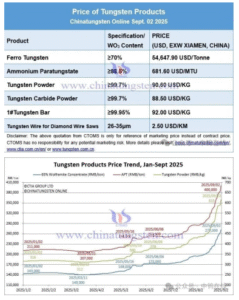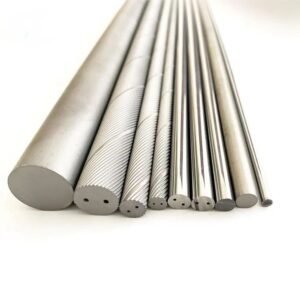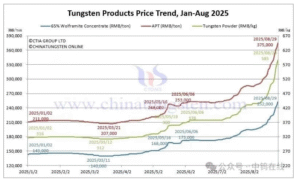Tungsten carbide inserts play a crucial role in modern machining, providing exceptional hardness, wear resistance, and efficiency in metal cutting applications. However, their performance depends on multiple factors, including material composition, coating, geometry, machining conditions, and tool maintenance. Understanding these factors helps manufacturers optimize tool life, improve machining accuracy, and reduce costs.
This article explores the key factors that affect the performance of tungsten carbide inserts and how to maximize their effectiveness in different machining applications.
1. Material Composition and Grade Selection
Tungsten carbide inserts are made from tungsten carbide (WC) powder bonded with a metallic binder, typically cobalt (Co) or nickel (Ni). The composition and grade of the carbide greatly impact its hardness, toughness, and wear resistance.
Common tungsten carbide grades include high cobalt content (10-15%), which increases toughness and is ideal for interrupted cuts or rough machining. Low cobalt content (3-8%) increases hardness and wear resistance, making it best for continuous cutting of hardened materials. The addition of titanium carbide (TiC) or tantalum carbide (TaC) enhances resistance to abrasion and heat, making the insert suitable for high-speed machining.
Choosing the right grade prevents premature tool failure. Higher hardness grades improve wear resistance but may be more brittle, while higher toughness grades resist chipping and cracking in interrupted cuts. Selecting the appropriate carbide grade based on the material and cutting conditions is essential for maximizing performance.
2. Coating Type and Quality
Coatings on tungsten carbide inserts significantly enhance their performance by reducing wear, improving heat resistance, and minimizing friction.
Common coating types include chemical vapor deposition (CVD), which is best for heavy-duty cutting, providing thicker coatings and superior wear resistance. Physical vapor deposition (PVD) is used for high-precision applications, providing thinner, harder coatings with better adhesion.
Popular coating materials include titanium nitride (TiN), which improves wear resistance and reduces friction, titanium carbonitride (TiCN), which enhances hardness and thermal stability, titanium aluminum nitride (TiAlN), which offers excellent high-temperature performance, and aluminum oxide (Al₂O₃), which increases heat resistance and is ideal for dry machining.
Coatings extend tool life by reducing insert wear. Lower friction reduces cutting forces, improving machining efficiency, while proper coating selection prevents material adhesion and improves surface finish. Using the right coating for the material and cutting speed can dramatically improve insert longevity and performance.
3. Insert Geometry and Edge Preparation
The shape, size, and edge preparation of a tungsten carbide insert impact its cutting efficiency, stability, and tool life.
Different insert shapes offer various advantages. Round inserts distribute cutting forces evenly and are best for high-feed machining. Square inserts provide strength and are suitable for roughing operations. Triangular inserts offer a balance between sharpness and stability, while diamond-shaped inserts are ideal for finishing and precision cuts.
Edge preparation also plays a role in performance. A sharp edge is best for light cutting and precision work but is more prone to chipping. A chamfered edge increases toughness and prevents chipping in heavy-duty applications. A honed edge strengthens the cutting edge and improves durability in interrupted cuts.
Choosing the right insert shape optimizes cutting stability and tool life. Edge preparation reduces tool breakage, preventing costly downtime, while proper geometry selection enhances cutting efficiency and minimizes cutting forces.
4. Cutting Parameters (Speed, Feed, and Depth of Cut)
The way tungsten carbide inserts perform depends heavily on how they are used in machining operations.
Key cutting parameters include cutting speed, measured in meters per minute (m/min) or surface feet per minute (SFM). A speed that is too high can cause thermal wear, while a speed that is too low can lead to built-up edge formation. Feed rate, measured in millimeters per revolution (mm/rev) or inches per tooth (IPT), affects chip thickness and tool load. Depth of cut, measured in millimeters or inches, determines cutting forces and heat generation.
Optimal cutting speeds prevent premature wear and maximize tool life. Correct feed rates prevent excessive insert loading, reducing chipping risks. Proper depth of cut selection balances material removal and insert wear. Following the manufacturer’s recommended cutting parameters ensures efficient material removal and extended insert life.
5. Workpiece Material and Machining Conditions
The type of material being machined has a direct effect on the performance and lifespan of tungsten carbide inserts.
Soft materials like aluminum, brass, and plastics require sharp cutting edges and high cutting speeds. Steel and stainless steel benefit from coated carbide inserts for heat and wear resistance. Hardened materials and superalloys such as Inconel and titanium require specialized grades with advanced coatings.
Matching the right insert to the workpiece material improves efficiency. Poor material selection can lead to rapid tool wear or breakage. Using coolant effectively prevents overheating and extends tool life. Different materials require different insert grades, coatings, and machining speeds for optimal results.
6. Tool Holding and Machine Stability
Even the best tungsten carbide insert will not perform well if the tool holder and machine setup are not stable.
Factors affecting stability include high-quality tool holders that reduce vibration and improve accuracy. Correct clamping torque ensures inserts remain secure. Machine rigidity and stability minimize deflection and chatter.
Stable tool holding increases cutting accuracy and prevents insert movement. Minimized vibration improves surface finish and tool longevity. Using the right holder and machine settings maximizes insert effectiveness. Proper tool holding and machine setup are just as important as choosing the right insert.
7. Insert Maintenance and Replacement Timing
Proper care and timely replacement of tungsten carbide inserts can significantly affect performance and machining costs.
Best practices for insert maintenance include regularly inspecting inserts for wear, chipping, or built-up edge formation. Rotating or indexing inserts when edges show signs of dulling ensures even wear. Storing inserts in dry, clean environments prevents oxidation or contamination.
Regular maintenance prevents tool failure, reducing downtime. Replacing inserts at the right time ensures consistent machining quality. Proper storage and handling extend insert lifespan, lowering costs. Following preventive maintenance practices ensures maximum insert performance and cost-effectiveness.
Conclusion
The performance of tungsten carbide inserts depends on a combination of factors, including material composition, coatings, geometry, machining conditions, and maintenance. Understanding and optimizing these factors allows manufacturers to maximize tool life, reduce operational costs, and improve machining performance.
By carefully selecting the right insert grade, coating, cutting parameters, and tool-holding setup, machinists can unlock the full potential of tungsten carbide inserts, achieving superior efficiency and precision in their operations.
Need help selecting the best tungsten carbide inserts for your machining needs? Contact us today for expert guidance and premium cutting solutions.





